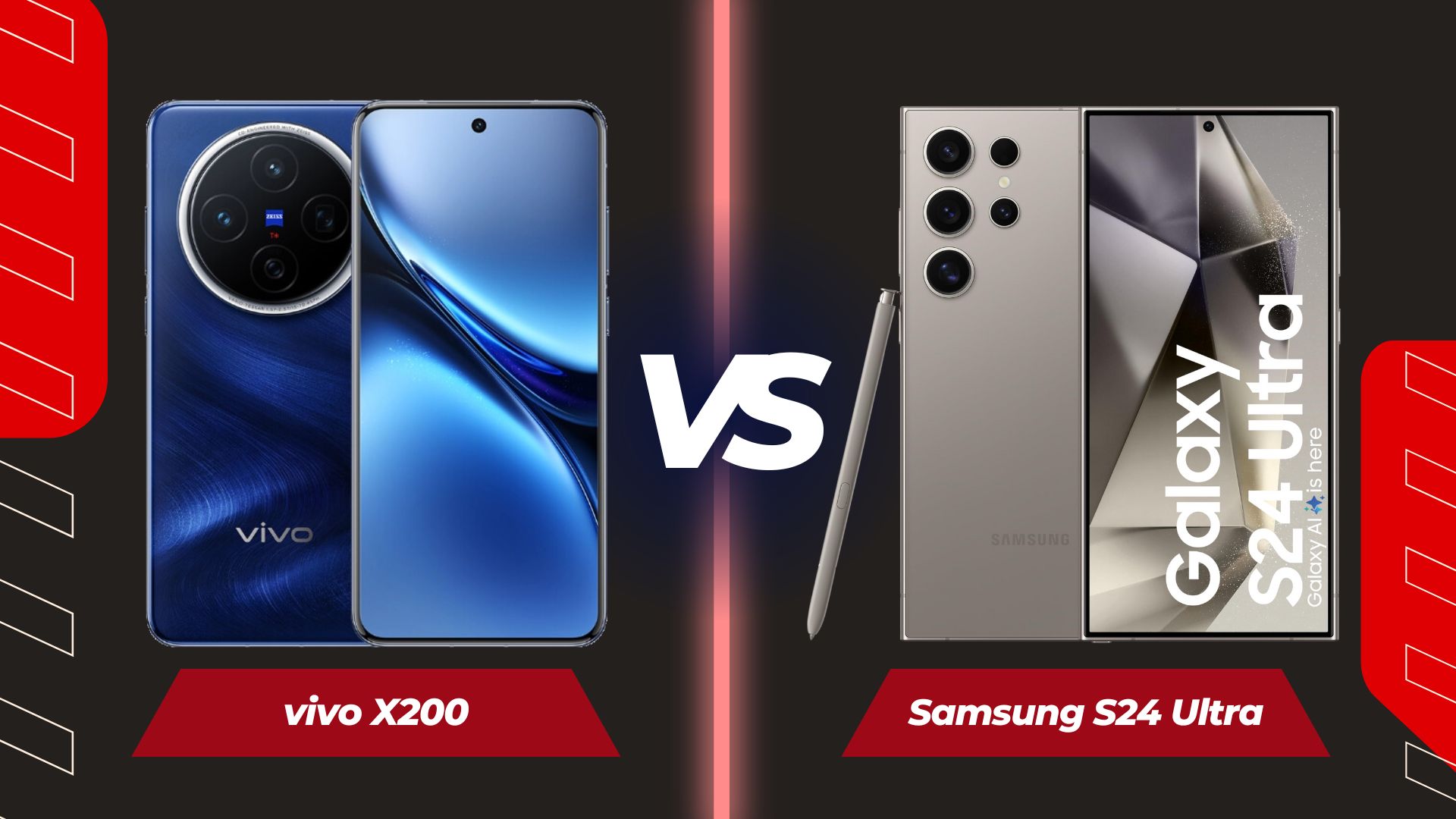
The smartphone battleground is fierce, and two titans are currently vying for the crown: the Vivo X200 and the Samsung Galaxy S24 Ultra. Both phones are armed with top-tier specs and innovative features, making the choice a challenging one. To help you navigate this dilemma, we delve deep into a comprehensive comparison, exploring every facet of these flagship contenders.
Design and Durability: Vivo X200 vs Samsung Galaxy S24 Ultra
Both the Vivo X200 and the Samsung Galaxy S24 Ultra exude an air of sophistication with their sleek designs and premium materials. However, their approaches to build quality differ significantly. The X200, with its aluminum alloy frame and glass front and back, prioritizes a lightweight and elegant form factor. It tips the scales at a mere 197g or 202g, making it comfortable to hold and use for extended periods. In contrast, the S24 Ultra adopts a more rugged approach, employing a titanium frame (grade 2) and Corning Gorilla Armor protection on both sides. This gives it a tank-like durability, though it comes at the cost of added weight, with the S24 Ultra weighing in at 232g or 233g. Both devices offer IP68 dust/water resistance, ensuring protection against accidental spills and submersion. However, the S24 Ultra goes a step further with an IP69 rating, making it resistant to high-pressure water jets. This added protection might appeal to those who frequently use their phones in challenging environments.
Another key differentiator is the inclusion of a stylus with the S24 Ultra. This Bluetooth-enabled pen, equipped with an accelerometer and gyro, unlocks a world of creative possibilities and enhances productivity. Whether you’re sketching, taking notes, or simply navigating the interface, the S24 Ultra’s stylus adds a unique dimension to the user experience.
Display: Vivo X200 vs Samsung Galaxy S24 Ultra
Both phones boast stunning displays that are sure to impress, but they cater to different preferences. The X200 features a vibrant 6.67-inch AMOLED panel with a smooth 120Hz refresh rate, support for HDR10+ content, and an impressive peak brightness of 4500 nits. This ensures a fluid and immersive viewing experience, even under direct sunlight. With a resolution of 1260 x 2800 pixels, the X200 achieves a pixel density of ~460 ppi, resulting in crisp and detailed visuals.
The S24 Ultra, on the other hand, opts for a larger 6.8-inch Dynamic LTPO AMOLED 2X display. This advanced panel also boasts a 120Hz refresh rate and HDR10+ support, but it dials down the peak brightness to 2600 nits. However, it compensates with a higher resolution of 1440 x 3120 pixels, achieving a sharper pixel density of ~505 ppi. The S24 Ultra’s display also benefits from Corning Gorilla Armor protection and an always-on display functionality, providing at-a-glance information without waking the device.
Performance and Software: Vivo X200 vs Samsung Galaxy S24 Ultra
When it comes to raw power, both the X200 and S24 Ultra are no slouches. The X200 is fueled by the cutting-edge Mediatek Dimensity 9400 (3 nm) chipset, featuring an Octa-core CPU configuration with a clock speed reaching 3.63 GHz. This processor, coupled with the Immortalis-G925 GPU, promises exceptional performance for demanding tasks and graphically intensive games.
The S24 Ultra counters with the equally formidable Qualcomm SM8650-AC Snapdragon 8 Gen 3 (4 nm) chipset. This 8-core CPU also delivers blazing-fast performance, ensuring a smooth and responsive user experience. While both chipsets are top-of-the-line, the choice between them might come down to specific benchmark results and individual app optimizations.
On the software front, the X200 runs on Android 15 with Vivo’s custom OriginOS 5 skin (in China). OriginOS offers a unique and highly customizable user interface with a focus on visual flair and innovative features. The S24 Ultra, meanwhile, ships with Android 14 and Samsung’s refined One UI 6.1.1. One UI is known for its clean aesthetic, intuitive navigation, and seamless integration with Samsung’s ecosystem. Samsung also promises up to 7 major Android upgrades for the S24 Ultra, ensuring long-term software support and access to the latest features.
Camera: Vivo X200 vs Samsung Galaxy S24 Ultra
Both the X200 and S24 Ultra pack powerful camera systems that cater to photography enthusiasts. The X200 boasts a triple rear camera setup, headlined by a 50 MP main sensor with an impressive f/1.6 aperture, 1/1.56″ sensor size, PDAF, and OIS. This is complemented by a 50 MP periscope telephoto lens with 3x optical zoom and a 50 MP ultrawide lens for capturing expansive landscapes. Vivo has partnered with renowned optics manufacturer Zeiss to enhance the X200’s camera capabilities. The inclusion of Zeiss optics and Zeiss T lens coating* promises superior image quality with reduced reflections and improved light transmission.
The S24 Ultra takes a different approach, focusing on sheer megapixel count and versatility. Its quad-camera system is led by a staggering 200 MP main sensor with an f/1.7 aperture, 1/1.3″ sensor size, multi-directional PDAF, and OIS. This is accompanied by a 10 MP telephoto lens with 3x optical zoom, a 50 MP periscope telephoto lens with 5x optical zoom, and a 12 MP ultrawide lens. This diverse array of lenses allows for a wide range of shooting scenarios, from capturing detailed close-ups to expansive panoramas.
Both phones offer a plethora of camera features, including Laser AF, LED flash, auto-HDR, and panorama modes. They also support high-resolution video recording, with the X200 capable of capturing 4K footage with gyro-EIS for stabilization, and the S24 Ultra going a step further with 8K video recording at 24/30fps and advanced features like HDR10+ and stereo sound recording.
Battery and Charging: Vivo X200 vs Samsung Galaxy S24 Ultra
Battery life is a crucial factor for any smartphone, and both the X200 and S24 Ultra aim to deliver. The X200 packs a substantial 5800 mAh Si/C battery, utilizing advanced silicon-carbon technology for improved energy density. It supports blazing-fast 90W wired charging, allowing you to replenish the battery quickly. Additionally, the X200 offers reverse wired charging, enabling you to use it as a power bank to charge other devices.
The S24 Ultra, while having a slightly smaller 5000 mAh Li-Ion battery, offers a more versatile charging experience. It supports 45W wired charging, 15W wireless charging (Qi/PMA), and 4.5W reverse wireless charging. This gives you the flexibility to charge your phone in various ways, depending on your needs and preferences.
Connectivity and Additional Features: Vivo X200 vs Samsung Galaxy S24 Ultra
Both phones offer a comprehensive suite of connectivity options, including dual SIM support, NFC for contactless payments, and the latest Wi-Fi standards. The X200 features Bluetooth 5.4 with support for high-quality audio codecs like aptX HD and LHDC 5. The S24 Ultra, on the other hand, has Bluetooth 5.3 and supports Ultra Wideband (UWB) technology for precise location tracking and device interaction.
The X200 also includes an infrared port, allowing you to control compatible appliances like TVs and air conditioners. The S24 Ultra, meanwhile, offers Samsung DeX support, transforming your phone into a desktop-like experience when connected to an external display. It also features Samsung Wireless DeX for a truly wireless setup.
The Verdict: Choosing Your Champion
The Vivo X200 and Samsung Galaxy S24 Ultra are both formidable flagship smartphones that excel in different areas. The X200 impresses with its lightweight design, vibrant display, powerful performance, and long-lasting battery. The S24 Ultra counters with its rugged build, versatile camera system, stylus support, and advanced features like DeX and UWB.
Ultimately, the best choice depends on your individual priorities and preferences. If you value a lightweight and stylish design, a long-lasting battery, and a capable camera with Zeiss optics, the X200 might be the perfect fit. If you prioritize durability, a versatile camera system with a high megapixel count, a stylus for enhanced productivity, and seamless integration with Samsung


















